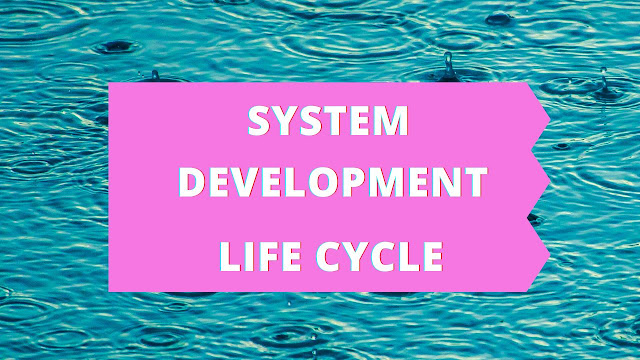 |
| System development Life Cycle |
System Development Life Cycle
The framework advancement life cycle (SDLC) is
the most common way of creating and carrying out a data framework. A strategy
is a conventional approach to taking care of an issue in an organized way.
Utilizing a system with a thorough cycle with clear targets expands
achievement. When the system is taken on, needs are set and a group of
individuals is chosen and responsible for achieving the venture objectives. The
customary SDLC has six general stages. The cascade model displayed in the
figure shows the occasions toward the start of each segment and the data got
from the past. Toward the finish of each stage there is a precise survey or
rude awakening, wherein the group chooses whether to proceed with the task, cut
it, discharge it, defer it or move it to the primary stage, not entirely set in
stone to proceed with the venture to the surprise of no one. also, as proper.
unique abilities, authoritative abilities or different assets. When the
framework is carried out, it is kept up with (and altered) all through its
lifecycle. The execution of any data framework has numerous emphasess on the
grounds that the cycle can rehash the same thing over the long haul. With
consistent survey and development, any data security framework, specifically,
can live up to the assumptions of the steadily evolving climate.
1.Investigation
The initial step
is research, which is the most significant. What issue should the improvement
framework tackle? The examination cycle starts with the evaluation of the item
or administration that starts the interaction. The examination stage
characterizes the objectives, imperatives and extent of the undertaking. A
money saving advantage investigation centers basically around the advantages
and the degree of worth of the products. Toward the finish of this stage and at
each resulting stage, the assessment can evaluate the monetary, specialized and
conduct parts of the framework and guarantee that it demands the investment and
exertion of the organization.the application.
2. Analysis
The assessment cycle starts with the data gave
during the exploration interaction. The essential focal point of this
interaction is to survey the association, its ongoing approaches and to add to
the proposed arrangement. Investigators start by making sense of what the new
framework will do and how it squeezes into the current framework. This cycle is
finished by recording and checking the outcomes as they happen
3. Logical Design
In the
consistent plan stage, data acquired from the examination stage is utilized to
start taking care of business issues. The most important phase in any
arrangement is to recognize the requirements of the organization. In view of
the business necessities, the application is chosen to offer the expected types
of assistance, and the media and frameworks are chosen to give the necessary
access. At last, in the wake of examining every one of the abovementioned,
different advancements for the execution of visual arrangements are introduced.
In this way, the legitimate plan is the outline for the ideal arrangement. The
consistent plan is application free, and that implies there are no references
to explicit advances, sellers, or items. All things being equal, the proposed
framework works in a way that tackles the main pressing issue. At this stage,
the expert creates a few elective arrangements, each with its overall assets
and shortcomings, as well as expenses and advantages, permitting an overall
correlation of the accessible choices. After this step, further dissects can be
performed.
4. Physical Design
In the actual plan stage, explicit advances
are chosen to help the options recognized and assessed in the consistent plan.
The parts chose depend on a form or purchase choice (introduce the parts
locally or buy from a merchant). The end result contains different parts and
advancements. After the plausibility examination, the whole arrangement is
introduced to the association's administration for endorsement.
5. Implementation
In the execution stage, all the essential
programming is created. The gadgets have been requested, got and tried. From
that point forward, clients are prepared and it is made to help documentation.
After individual testing of all parts, they are introduced as a framework and
tried. The possibility examination was rehashed and submitted to the framework
supporter for execution assessment and acknowledgment testing.
6. Maintenance and Change
The upkeep and change stage is the longest and
most costly period of the cycle. This stage expects exercises to help and alter
the framework for the rest of its valuable life cycle. Albeit this conventional
advancement stage might be finished, the task lifecycle keeps on deciding if
the interaction ought to go on past the exploration stage. Framework
consistence is intermittently tried and its capacity to proceed and stop is
assessed. Use renditions, improvements and images. Frameworks should uphold the
association as the necessities of the association change. Frameworks executives
and allies should continually screen how the frameworks fit into the
association's current circumstance. At the point when the ongoing design can
never again uphold the developing association's central goal, the venture is
ended and another undertaking is carried out.
tags
system development life cycle
system development life cycle pdf
System development life cycle model
5 phases of system development life cycle
System development life cycle in information security
7 stages of system development life cycle
System development life cycle example
System Development Life Cycle ppt
System Development Life Cycle notes
system development life cycle slideshare
what is system life cycle


.jpg)

.jpg)

Thank you for such a guidebook! I've been interested in System Development for quite a time, doing research is much more pleasant when finding coherent and valuable texts :)
ReplyDelete